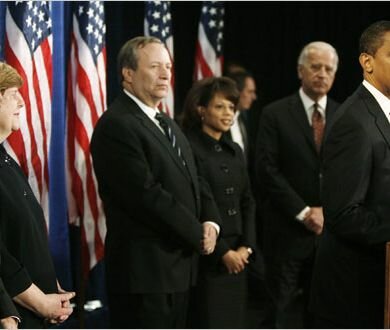Beyond the Noise — 12 Ways Obama is Building More Equitable America
Featured — By PolicyLink on January 21, 2010 at 07:11This post was written by PolicyLink founder and CEO Angela Glover Blackwell.
The first year of the Obama Era has been defined by noise – voracious political pundits, screaming Tea Partiers, and cries of “too left” and “not left enough” from competing corners of political world. With the surprise election of Scott Brown yesterday following a loud and boisterous campaign built on voters’ anger at a still-stagnant economy, the noise isn’t likely to ebb soon.
But quietly, under-the-radar and away from the cameras, the Obama Administration has been diligently working to lay the foundation for a more vibrant and equitable America. Of course, not all of these projects and proposals have had time to show results yet — but, over the long-term, they will significantly improve the lives of low-income people of color.
These are the twelve vital ways Obama is building a more equitable nation for you and your kids.
1. Created the White House Office of Urban Affairs
Our first truly urban president in generations has put the unique challenges of cities and city residents at the forefront of his domestic agenda. During a national listening tour last year, several cabinet secretaries joined some of the nation’s top urban policy thinkers and advocates to highlight the most innovative and promising local community-building efforts. Our best ideas come from the communities closest to our challenges. The Office of Urban Affairs gets that.
2. Funded the “Pathways Out of Poverty” program
The Department of Labor ensured disadvantaged communities will have a prominent role in the coming wave of green jobs. The program has already awarded $150 million in grants to job-training and job-placement programs across the country, from St. Louis, Mo., to Ocala, Fla., to Apache Junction, Ariz. This is part of a larger $650 million job training effort funded by the American Recovery and Reinvestment Act.
3. Improved Our Health by Investing in Community-Level Prevention Efforts
The Recovery Act set aside $1 billion for prevention and wellness programs. This money helps fund traditional health-care efforts like community clinics and immunizations. But it also goes beyond health-care to include expanding access to healthy foods in our schools and communities and ensuring residents have healthy and safe places to live and play.
4. Gave the Gulf Coast the Resources They Need to Rebuild – And the Space to Do It
When Obama took office more than three years after Hurricane Katrina, local residents were still facing myriad frustrating and indefensible challenges to rebuilding. Red tape and misdirected programs still prevented many people from rebuilding their homes and moving back to the city. Entire communities remained empty. Obama put people on the ground with authority to help local leaders cut through the bureaucracy. They redirected resources to meet housing needs for the most vulnerable. They authorized plans to rebuild safer community facilities. And just last week, Vice President Joe Biden announced that more than 100 communities that received $1.2 billion in disaster loans after the storm could apply to have those loans forgiven.
5. Forged the Sustainable Communities Initiative
A joint effort by HUD, the Department of Transportation, and the EPA, the Sustainable Communities initiative seeks to “improve access to affordable housing, more transportation options, and lower transportation costs while protecting the environment in communities nationwide.” This rare cross-agency collaboration is a promising attempt to break down the stovepipes and silos we see far too often in government.
6. Hosted the first White House meeting with all Tribal Nations leaders in 15 years
Leaders of all 564 federally recognized tribes came to the White House in November to meet with Obama and several cabinet secretaries to discuss issues of economic development, natural resources, public safety, housing, education, and health. This was the first such summit since the early 1990s – a sign of the administration’s significant commitment to Tribal Nations.
7. Got the Ball Rolling on Promise Neighborhoods
Since his days on the campaign trail, the president has trumpeted the remarkable success the Harlem Children’s Zone has had in breaking the cycle of inter-generational poverty. The Administration has already invested $10 million in planning dollars to help other communities develop their own neighborhood-based approaches to child poverty.
8. Connected Housing and Economic Opportunity through Choice Neighborhoods
Where you live determines the access people have to opportunity. By improving and expanding upon HUD’s HOPE VI program, Choice Neighborhoods would ensure that housing was linked to school reform, early childhood innovations, and supportive social services. Here, Obama saw a program that was showing some results and promise…and made it better.
9. Built on Successes of the Nonprofit Sector through the Social Innovation Fund
The Obama Administration has repeatedly recognized the crucial role the nation’s nonprofit infrastructure plays in ensuring all Americans have access to social and economic opportunities. In setting aside $50 million in seed money for the Social Innovation Fund, the administration made a commitment to expanding the capacity of the nonprofit sector and bringing the most proven, results-oriented innovations to scale.
10. Encouraged Access to Quality Jobs in Infrastructure Projects
We know the administration has made historic investments in our nation’s infrastructure. But what few people realize is that – through executive orders and new Office of Management and Budget guidelines – the administration has encouraged that investment will help create quality, well-paying jobs and guided those jobs to local residents.
11. Cracked Down on Mortgage Abuses that Tanked the Economy in the First Place
Unscrupulous lenders and poor-quality mortgage products have decimated the financial foundation of countless low-income neighborhoods and communities of color. By proposing the Consumer Financial Protection Agency to regulate consumer financial products, Obama has shined a much-needed light on the unfair and uneven impacts of a broken financial sector – and may help stop the next downturn before it starts.
12. Proposed Major investments in our community college system
Increasingly, community colleges are the most accessible and cost-effective way for young people (and older people) to get the beyond-high-school training you need for almost any good-paying job these days. In proposing a remarkable $12 billion investment to improve our community college system and help 5,000,000 additional people earn degrees and certificates by 2020, Obama demonstrated a commitment to helping lift up all people, including low-income people and people of color who are too often shut out of the cutting-edge economy.
Obama hits his one-year mark at a bumpy time, no doubt. But I hope he continues his quiet campaign to make America work for all people. Years from now, we will look back on the first year of the Obama Era as one when tough, smart choices got made. It may not pay off politically right now, but it will pay off in years to come in the form or a stronger, more equitable nation for all Americans.
Tags: African-Americans, american indians, Economy, Health, Housing, latinos, Politics News, Poverty, Racial EquityAuthor: PolicyLink (5 Articles)
PolicyLink is a national research and action institute advancing economic and social equity by Lifting Up What Works. Founded in 1999, PolicyLink connects the work of people on the ground to the creation of sustainable communities of opportunity that allow everyone to participate and prosper. Such communities offer access to quality jobs, affordable housing, good schools, transportation, and the benefits of healthy food and physical activity. Guided by the belief that those closest to the nation’s challenges are central to finding solutions, PolicyLink relies on the wisdom, voice, and experience of local residents and organizations. Lifting Up What Works is our way of focusing attention on how people are working successfully to use local, state, and federal policy to create conditions that benefit everyone, especially people in low-income communities and communities of color. We share our findings and analysis through our publications, website and online tools, convenings, national summits, and in briefings with national and local policymakers. Our work is grounded in the conviction that equity—just, fair, and green inclusion—must drive all policy decisions.



 Share This
Share This Tweet This
Tweet This Digg This
Digg This Save to delicious
Save to delicious Stumble it
Stumble it





 Sometimes the rainbow is not enuf
Sometimes the rainbow is not enuf The Border Network for Human Rights: Building an immigrant movement in the besieged borderlands
The Border Network for Human Rights: Building an immigrant movement in the besieged borderlands








1 Comment